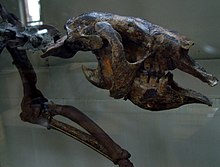Thalassocnus
Appearance
| Thalassocnus Temporal range:
| |
|---|---|

| |
| Thalassocnus skeleton, Muséum national d'histoire naturelle, Paris | |
| Scientific classification | |
| Kingdom: | |
| Phylum: | |
| Class: | |
| Subclass: | |
| Infraclass: | |
| Superorder: | |
| Order: | |
| Family: | |
| Subfamily: | |
| Genus: | †Thalassocnus de Muizon & McDonald, 1995
|
| Species | |

Thalassocnus is an extinct genus of semi-aquatic or aquatic marine sloth from the Miocene and Pliocene of South America. Fossils found to date have been from the coast of Peru. They were apparently grazers of sea grass and seaweed. Over time, they apparently shifted from a preference for feeding in shallow water to a preference for deeper waters.[1] They may have used their powerful claws to anchor themselves to the sea floor to facilitate feeding, similar to the behavior of the marine iguana.[1]
Notes
- ^ a b Muizon, C. de (2004). "The evolution of feeding adaptations of the aquatic sloth Thalassocnus". Journal of Vertebrate Paleontology. 24 (2). Society of Vertebrate Paleontology: 398–410. doi:10.1671/2429b.
{{cite journal}}: Unknown parameter|coauthors=ignored (|author=suggested) (help); Unknown parameter|month=ignored (help)
References
- McDonald, H. G. (2002). "The cranial anatomy of Thalassocnus (Xenarthra, Mammalia), a derived nothrothere from the Neogene of the Pisco Formation (Peru)". Journal of Vertebrate Paleontology. 22 (2). Society of Vertebrate Paleontology: 349–365. doi:10.1671/0272-4634(2002)022[0349:TCAOTX]2.0.CO;2.
{{cite journal}}: Unknown parameter|coauthors=ignored (|author=suggested) (help); Unknown parameter|month=ignored (help) - William F. Perrin, Bernd Wursig, and J. G.M. Thewissen. Encyclopedia of Marine Mammals, Pg.72.
- Muizon, C. de (1995-05-18). "An aquatic sloth from the Pliocene of Peru". Nature. 375 (6528). Nature Publishing Group: 224–227. doi:10.1038/375224a0.
{{cite journal}}: Unknown parameter|coauthors=ignored (|author=suggested) (help) - World Encyclopedia of Dinosaurs & Prehistoric Creatures: The Ultimate Visual Reference To 1000 Dinosaurs And Prehistoric Creatures Of Land, Air And Sea ... And Cretaceous Eras (World Encyclopedia) by Dougal Dixon
